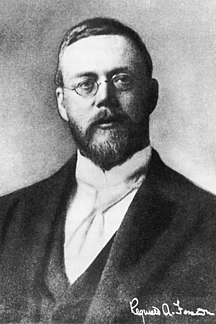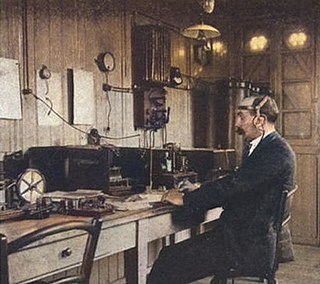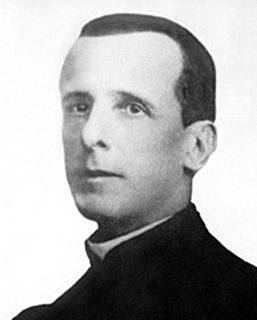Related Research Articles

Sir John Ambrose Fleming FRS was an English electrical engineer and physicist who invented the first thermionic valve or vacuum tube, designed the radio transmitter with which the first transatlantic radio transmission was made, and also established the right-hand rule used in physics. He was the eldest of seven children of James Fleming DD, a Congregational minister, and his wife Mary Ann, at Lancaster, Lancashire, and baptised on 11 February 1850. A devout Christian, he once preached at St Martin-in-the-Fields in London on evidence for the resurrection. In 1932, he and Douglas Dewar and Bernard Acworth helped establish the Evolution Protest Movement. Fleming bequeathed much of his estate to Christian charities, especially those for the poor. He was a noted photographer, painted water colours, and enjoyed climbing the Alps.

A telephone, or phone, is a telecommunications device that permits two or more users to conduct a conversation when they are too far apart to be heard directly. A telephone converts sound, typically and most efficiently the human voice, into electronic signals that are transmitted via cables and other communication channels to another telephone which reproduces the sound to the receiving user.

Wireless telegraphy or radiotelegraphy is transmission of telegraph signals by radio waves; Before about 1910 when radio became dominant, the term wireless telegraphy was also used for various other experimental technologies for transmitting telegraph signals without wires, such as electromagnetic induction, and ground conduction telegraph systems.

In telecommunication and signal processing companding is a method of mitigating the detrimental effects of a channel with limited dynamic range. The name is a portmanteau of the words compressing and expanding. The use of companding allows signals with a large dynamic range to be transmitted over facilities that have a smaller dynamic range capability. Companding is employed in telephony and other audio applications such as professional wireless microphones and analog recording.

The photophone is a telecommunications device that allows transmission of speech on a beam of light. It was invented jointly by Alexander Graham Bell and his assistant Charles Sumner Tainter on February 19, 1880, at Bell's laboratory at 1325 L Street in Washington, D.C. Both were later to become full associates in the Volta Laboratory Association, created and financed by Bell.

A microphone, colloquially named mic or mike, is a device – a transducer – that converts sound into an electrical signal. Microphones are used in many applications such as telephones, hearing aids, public address systems for concert halls and public events, motion picture production, live and recorded audio engineering, sound recording, two-way radios, megaphones, radio and television broadcasting, and in computers for recording voice, speech recognition, VoIP, and for non-acoustic purposes such as ultrasonic sensors or knock sensors.

Reginald Aubrey Fessenden was a Canadian-born inventor, who did a majority of his work in the United States and also claimed U.S. citizenship through his American-born father. During his life he received hundreds of patents in various fields, most notably ones related to radio and sonar.

AM broadcasting is a radio broadcasting technology, which employs amplitude modulation (AM) transmissions. It was the first method developed for making audio radio transmissions, and is still used worldwide, primarily for medium wave transmissions, but also on the longwave and shortwave radio bands.

Johann Philipp Reis was a self-taught German scientist and inventor. In 1861, he constructed the first make-and-break telephone, today called the Reis telephone.

Nathan Beverly Stubblefield, self-described "practical farmer, fruit grower and electrician", was an American inventor best known for his wireless telephone work. He received widespread attention in early 1902 when he gave a series of public demonstrations of a battery-operated wireless telephone, which could be transported to different locations and used on mobile platforms such as boats. While this initial design employed conduction, in 1908 he received a U.S. patent for a wireless telephone system that used magnetic induction. However, he was ultimately unsuccessful in commercializing his inventions. He later went into seclusion, and died alone in 1928.

The Reis telephone was an invention named after Philipp Reis of a telephonelike device he constructed. Reis's first successful work is dated to October 1861.

A crystal detector is an obsolete electronic component in some early 20th century radio receivers that used a piece of crystalline mineral as a detector (demodulator) to rectify the alternating current radio signal to extract the audio modulation which produced the sound in the earphones. It was the first type of semiconductor diode, and one of the first semiconductor electronic devices. The most common type was the so-called cat whisker detector, which consisted of a piece of crystalline mineral, usually galena, with a fine wire touching its surface. The "asymmetric conduction" of electric current across electrical contacts between a crystal and a metal was discovered in 1874 by Karl Ferdinand Braun. Crystals were first used as radio wave detectors in 1894 by Jagadish Chandra Bose in his microwave experiments. Bose first patented a crystal detector in 1901. The crystal detector was developed into a practical radio component mainly by G. W. Pickard, who began research on detector materials in 1902 and found hundreds of substances that could be used in forming rectifying junctions. The physical principles by which they worked were not understood at the time they were used, but subsequent research into these primitive point contact semiconductor junctions in the 1930s and 1940s led to the development of modern semiconductor electronics.

The invention of radio communication, although generally attributed to Guglielmo Marconi in the 1890s, spanned many decades, from theoretical underpinnings, through proof of the phenomenon's existence, development of technical means, to its final use in signalling.

The carbon microphone, also known as carbon button microphone, button microphone, or carbon transmitter, is a type of microphone, a transducer that converts sound to an electrical audio signal. It consists of two metal plates separated by granules of carbon. One plate is very thin and faces toward the speaking person, acting as a diaphragm. Sound waves striking the diaphragm cause it to vibrate, exerting a varying pressure on the granules, which in turn changes the electrical resistance between the plates. Higher pressure lowers the resistance as the granules are pushed closer together. A steady direct current is passed between the plates through the granules. The varying resistance results in a modulation of the current, creating a varying electric current that reproduces the varying pressure of the sound wave. In telephony, this undulating current is directly passed through the telephone wires to the central office. In public address systems it is amplified by an audio amplifier. The frequency response of most carbon microphones, however, are limited to a narrow range, and the device produces significant electrical noise.

Father Roberto Landell de Moura, commonly known as Roberto Landell, was a Brazilian Roman Catholic priest and inventor. He is best known for his work developing long-distance audio transmissions, using a variety of technologies, including an improved megaphone device, photophone and radio signals.

Archie Frederick Collins, who generally went by A. Frederick Collins, was a prominent early American experimenter in wireless telephony and prolific author of books and articles covering a wide range of scientific and technical subjects. His reputation was tarnished in 1913 when he was convicted of mail fraud related to stock promotion. However, after serving a year in prison, he returned to writing, including, beginning in 1922, The Radio Amateur's Handbook, which continued to be updated and published until the mid-1980s.

Henry Sutton was an Australian designer, engineer, and inventor credited with contributions to early developments in electricity, aviation, wireless communication, photography and telephony.
Radium, and Other Radio-active Substances; Polonium, Actinium, and Thorium is a book published in 1903 by William Joseph Hammer, when he was about 50 years old. The book is the text of a lecture delivered at a meeting of the American Institute of Electrical Engineers. The title of the lecture was "Radium and other radioactive substances with a consideration of phosphorescent and fluorescent substances. The properties and applications of selenium and the treatment of disease by the ultra violet light". The lecture was augmented by 38 lantern slides, which are reproduced in the book.
Dr James Robert Erskine-Murray FRSE MIEE (1868-1927) was a Scottish electrical engineer and inventor. A protege of Lord Kelvin ha also worked with Marconi and was a pioneer in the development of the telegraph. He wrote extensively on telegraphy and wireless communication.
Ernst Walter Ruhmer was a German physicist. He was best known for investigating practical applications making use of the light-sensitivity properties of selenium, which he employed in developing wireless telephony using line-of-sight optical transmissions, sound-on-film audio recording, and television transmissions over wires.
References
- ↑ "TO PHOTOGRAPH YOUR TALK". The Coburg Leader . XXII (37). Victoria, Australia. 19 September 1903. p. 3. Retrieved 30 October 2019– via National Library of Australia. , ...A small electric-motor moves the rolls at the rate of 12ft per second...
- ↑ "SCIENTIFIC". The Australasian . LXX (1838). Victoria, Australia. 22 June 1901. p. 51. Retrieved 30 October 2019– via National Library of Australia.
- ↑ "TALKING THROUGH A RAY OF LIGHT". The Border Morning Mail And Riverina Times . IV (1081). New South Wales, Australia. 4 May 1907. p. 6. Retrieved 30 October 2019– via National Library of Australia.
- ↑ Wireless Telephony In Theory and Practice by Ernst Ruhmer (translated from the German by James Erskine-Murray), 1908, Page 36, Chapter IV. The Photographophone.
- ↑ Wireless Telephony In Theory and Practice by Ernst Ruhmer (translated from the German by James Erskine-Murray), 1908, Page 40, Photo
- ↑ Wireless Telephony In Theory and Practice by Ernst Ruhmer (translated from the German by James Erskine-Murray), 1908, page 39.